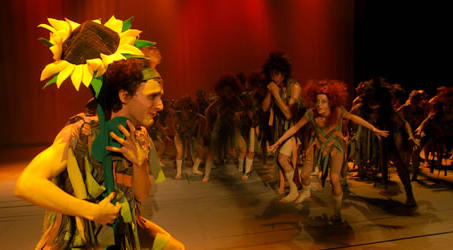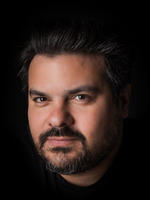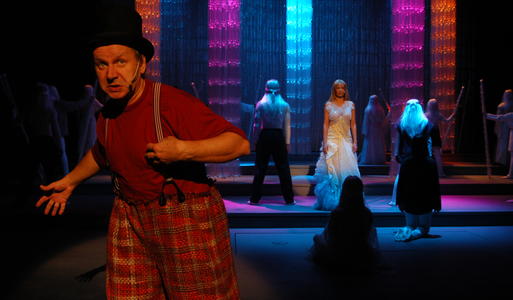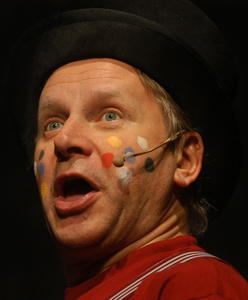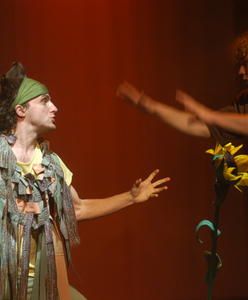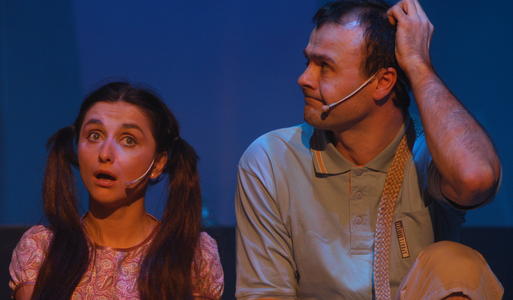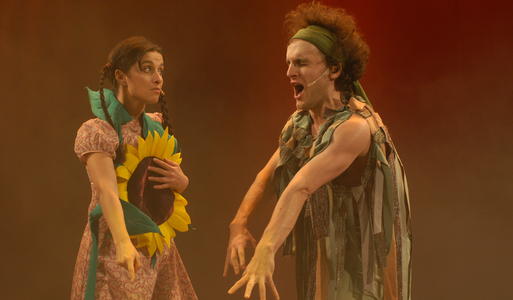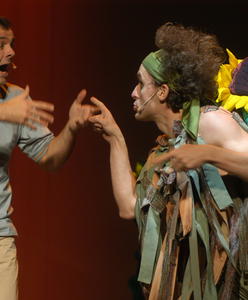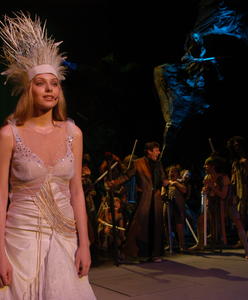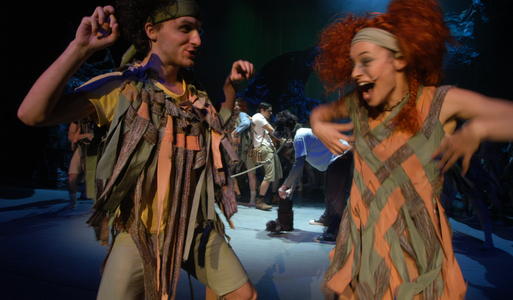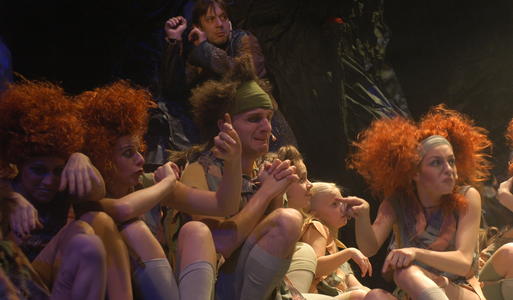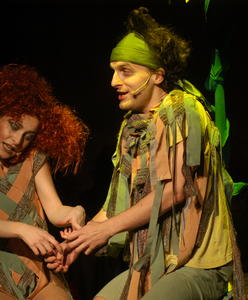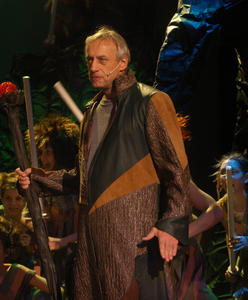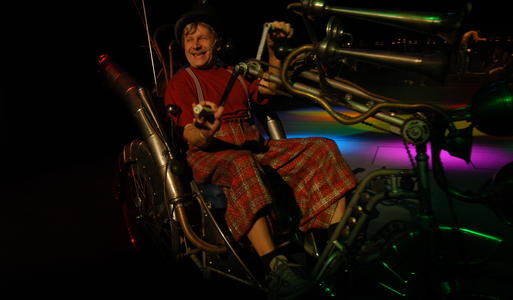"The Garden of Miracles" has not said good-bye to the Brno City Theatre-goers just yet!
28. January 2008
The well-known and popular authorial duo, Zdenek Merta and Stanislav Moša, have always enjoyed playing with fairy-tale like figures in their productions. However, all of their productions up to now have been made for mainly adult or adolescent spectators, even though they were also certainly attended by younger ones. However, "The Garden of Miracles" is aimed at a child audience, starting from pre-school age. Adult spectators will also find the unmistakable poetry of this duo within it, though.
"The Garden of Miracles" tells the story of how a boy called Snažík (Jakub Uličník), a girl, Chvilka (Mária Lalková) and a dog, Bafstein (Stano Slovák) are trying, with the help of the mighty queen Ahinsa (Michaela Horká), to protect a mysterious garden from bad goblins lead by the VERY evil Izera (Ladislav Kolář). The children and their parents are taken through the story by a congenial fellow called Gumpán (Erik Pardus), who always enters the action at the right moment and translates the more complex ideas for the youngest ones, of whom there are a lot in the auditorium.
This production does not simply rely on catchy melodies (the most distinct composition is definitely "Baf se baf") within the genre and target orientation, or on the attractive plot which also offers an impressive, tasteful show that captured the imagination of the audience through the inventive scenography by Jaroslav Milfajt. Let's mention the flying pink elephant, dancing mammoth or the volcanic eruption, to name a few elements. This alone would probably be enough by the standards of Czech children's productions to maintain a decent primacy, at least as far as the visual aspect is concerned. But this performance also requires direct and swift cooperation from the spectators, which is something quite unique, and after the end of the performance the children's eyes are shining, and so are the eyes of their parents.
We have good news for theatre-goers who have taken a liking to this extremely enjoyable piece. Even though last January's performances were supposed to be final ones, according to the official news from Brno City Theatre "The Garden of Miracles" will appear in the programme of performances at least three more times, thanks to the great interest of spectators and their excited reactions, probably in May this year, and hopefully in front of a full auditorium again.
Let's hope that apart from further well made and literally magical repeats, we will also live to see the release of a recording with songs from this performance, as is the case for all the other works by this authorial duo of this theatre, and it would be a real shame not to release such charming musical material that "The Garden of Miracles" contains as a keepsake.
When an Elephant Is Flying Above the Audience and Candies Are Falling Down...
Tomáš Hejzlar 20. December 2004 zdroj Haló noviny
The Brno City Theatre Does Not Forget the Smallest Theatregoers
While the majority of Czech musical productions just diffuse awkwardly notoriously known themes (sometimes even classical works – from “Grandmother” by Božena Němcová up to “The Three Musketeers” by Dumas), The Brno City Theatre surprised the audience again: it offers an original work which does not copy any well-known title. And more: The Garden of Miracles written by the librettist and director Stanislav Moša and the composer Zdenek Merta and put on the newly open music scene is meant for children. This is the most significant fact about this novelty.
The new fairy tale attracts audiences not only with its resourceful (and topical!) idea, but also with its implementation. The authors perfectly utilized many technical conveniences of the Brno scene. The new musical was rehearsed under Moša’s direction in a record-breaking time, but the performance does not suffer from any shortcomings.
Conflict of the Good and the Evil
After the previous successful titles (Midsummer Nights Dreams, Bastard, Babylon and the World Full of Angels), the fruitful creative tandem Moša-Merta comes out of the old fairy tale principle of the eternal struggle of the good and the evil. Although this predicate makes a basis for a major part of fairy tales not only in the Czech literature but also in the world literature from antiquity until the present days. Moša culminates this dialectic with a dramatic effect. The good and the evil appear in a precisely formulated form. It is not just a simply tale of a kingdom jeoparized with the invasion of hobgoblins who destroy miracle gardens. It is a fundamental conflict of interests which the present children audience is surely familiar with. Moša does not only personalize but projects the theme in quite clear contours.
Hobgoblins – Reflection of Our Time
On the background of the story of two children and Bafstein the dog children get elementary information on morality. Spectators themselves are involved in the final victory of the good (»The fairy tale can only come out well if we help each other,« Moša said before the first night.) when the Kingdom of Humanity is endangered with the invasion of hobgoblins. They not only destroy miracle gardens, but they are samples of commercialized trash we meet permanently in our everyday life.
If Moša really responded to current imperfections of human communities (not only in this country!), he created a realistic representation with the same emotive reproach as critical realists did in literature followed by socially oriented poets and novelists of the most resounding names (including Karel Čapek). And it is good such work was created now and is meant for the generations who are only getting ready for their lives.
Flying Elephant and candies
There are even a four-meter moving mammoth and an inflatable elephant flying several times with a »pilot« over the audience during the performance, rotating its propellers and a tail. However, it is not a meretricious pose, just a response to the fact that children are mollycoddled with similar computer fictions since a cradle. There are more such effects which are not disturbing, just liven up the course of action (for example candies falling down the auditorium). The perfect children’s choir can be regarded as the greatest merit. Fairies alternate with bad hobgoblins in the brilliant choreography by Vladimír Kloubek which is not only imaginative and dynamic, but also perfectly polished in the synchronization of movements. The final effect is also due to Jaroslav Milfajt, author of the fairy tale scene and Andrea Kučerová, designer of adequately impressive costumes.
The Actors Have a Good Play
The role of narrator Gumpán who wittily moves forward the line of action, performing the function of a buffoonish crowd-pleaser, is alternated by Erik Pardus and Jan Mazák. While Pardus’s unique acting can be imagined, Mazák did not disappoint either: he not only contacts the audience with a due flair and a good sense of children’s humour, but he drags the audience in the stage action. The queen of white beings Ahinsa is also alternated very well: though I was sorry I could not be a witness of the masterful acting of Alena Antalová, Ivana Vaňková did not disappoint either (the third is Michaela Horká). The role of the girl Chvilka (Moment) was studied by Markéta Sedláčková and playful Mária Lalková. She can differentiate perfectly the peripeteias of character, be arrogantly peculiar or almost charismatically gentle. The boy Snažík (Endeavourer) is alternated by Alan Novotný, Tomáš Sagher and Jakub Uličník. The comic role of the dog is alternated by Stano Slovák and Petr Štěpán who conjured up smiles on the grimmest faces of adults.
Final impression? It is determined best by the children’s applause which is spontaneous and permanent!
The Brno Music Scene Became the Garden of Miracles
Jiří P. Kříž 11. December 2004 zdroj Právo
The Brno City Theatre Studied an Original Family Show by the Matched Couple of Authors Zdenek Merta and Stanislav Moša
The Music Scene of the Brno City Theatre gets things really going. After the professionally successful Hair and sadly unconvincing operetta Merry Widow the matched couple of authors Zdenek Merta and Stanislav Moša appeared with a novelty – the Garden of Miracles.
Astonishing things happen in the Garden of Miracles. The friendly clown and narrator (Jan Mazák or Erik Pardus) tells sad jokes and sets out with spectators to a fairyland. Jeering and bloodthirsty hobgoblins governed by their king (Ladislav Kolář or Jan Apolenář) want to subjugate white beings with their beautiful queen Ivana Vaňková, Alena Antalová or Michaela Horká.
Fireworks are exploding and saxifrage is breaking rocks in front of the audience, an elephant is flying over their heads and they become witnesses of Darwin’s theory on the humanization of monkeys when the hobgoblin Slump (always brilliant Ján Jackuliak or Oldřich Smysl) and his wife Zlotra (not less brilliant Radka Coufalová or Lenka Janíková) start to work and smell good as white beings. And it all ends with the beautiful Werichian lesson that we will do much altogether. As you know, it is a little different in real life.
Invitations to cooperate, tolerate, not to violate sound in Moša’s libretto, Merta’s songs are directed to completeness, though they will be hardly remembered by children in the auditorium, including the central one.
The Garden of Miracles is full of smoke, magic, colours and first, full of evil before the good wins. There are also selfless children (Markéta Sedláčková, Mária Lalková, Alan Novotný, Tomáš Sagher, Jakub Uličník) and a beautiful speaking dog Bafstein (Stano Slovák or Petr Štěpán). The dog is the loveliest though it walks on all fours on crutches.
Luboš Mareček 6. December 2004 zdroj MF Dnes
The Garden of Miracles Amuses and Ratiocinates
The new performance of the Brno City Theatre offers a neglected entertainment: children’s musical
A family show for adults and children is offered by the Garden of Miracles, new musical performed in weekend premieres by the Brno City Theatre. The couple of authors Zdenek Merta and Stanislav Moša, the latter also directs the performance, created a unique performance. Fairy-tale musicals for children could be counted on the fingers of one hand. In case of the Garden of Miracles the authors risked even more: no notoriously well-known fairy tale is hidden under the title; it is an original story about two children and a speaking dog who will reform a group of bad hobgoblins.
Moša’s libretto did not rely only on the black-and-white differentiation into the good and the defeated evil. Solidarity, selfless friendship and the joint work for others is spoken, sung and danced about in the Garden of Miracles. Small spectators as well as their grown-up companions are pulled off the stereotypes of the fairy-tale world.
Excursion to this garden is recommendable. A lot of enchanting dancing, imaginative scenes and contagious joy is in for the visitors to move forward the two-hour mummery. Everybody is fascinated with the elephant flying above the heads of spectators, the dancing mammoth, the spontaneity of twenty-six acting children or the motoric mastery of the principal couple of hobgoblins. Fortunately, the Garden of Miracles does not serve the ideas of solidarity in a dry didactic way. The theatrical magic of the fairy-tale musical will conjure many theatre-goers back to the new music scene.
Luboš Mareček, MF Dnes, 6th December 2004
Musical Garden of Miracles
(vž) 1. December 2004 zdroj Haló noviny
The couple of authors Zdenek Merta and Stanislav Moša is well-known in the world of Czech musical. They have been cooperating with success for more than ten years in mutual inspiration and mission.
For example their titles Midsummer Nights Dreams, Bastard, Babylon or the World Full of Angels sold out successfully the auditorium of the Brno City Theatre as well as performances abroad. In harmony with the present world trend, Merta and Moša create polygenre works between musical and contemporary opera. In March, they will put their new opera Roulette on the stage of the Prague State Opera. Another premiere, this time of their musical fairy tale The Garden of Miracles, will take place on December 3 and 4 on the new music scene of the Brno City Theatre. It is meant for a family audience who is so deeply involved in the action that the adults behave like children. The subtitle is “The story will come out well if we help one another”. In contrast to the ancient myth of struggle of the good and the evil it is a human story of children (twenty-six acting children) who help the victory of good, love and joy. Otherwise, it would come out badly, as if the ice age came back (a four-metre mammoth acts in the performance). The songs and texts written by experienced hands do not lack songfulness, humour and tenderness. The new music scene enables various effects (including a volcano explosion) and changes by fairy tale magic. The authors express their wish to improve the world through the theatre.
The Garden of Miracles in the Brno City Theatre
David Kroča 1. December -1 zdroj Czech Radio 3/Vltava
The Garden of Miracles by Zdenek Merta and Stanislav Moša differs in one basic point from other musical productions of the present time: it is seeking the maximum communication with the audience. The significance of this approach is already evident in the subtitle having the following wording: “Musical fairy-tale for children and adults which will only come out well if we help each other”. It is not only a motto of the entire project, but also an important key to select a theatrical language.
The story line of Moša’s scenario reveals the traces of the old religious legend about the fight of the good and the evil. In the fairy-tale the fight is represented by the struggle of white beings with bad hobgoblins jeopardizing with their invasion the last magic garden. The point is that the final victory of the good is mainly due to the spectators themselves. Gumpán, narrator and guide through the action, selects jointly with his wise dog Albert Bafstein two representatives of the audience who win the mighty king of hobgoblins during their fairy-tale wondering and “infect” finally his subjects with love and friendship.
The gradual change of bad, lazy and mumbling creatures is highlighted by casting children from the age of nine to fourteen in the roles of hobgoblins, so that finally the stage is overmastered literary with a dancing and singing children’s choir. The song to grow up a magic seed becomes a hit before its final performance celebrating victory because the spectators sing it several times jointly with the protagonists to help magic flowers grow up. The melodies by Zdenek Merta are not simple but thanks to repetitions they can be remembered, so the audience is singing the central song when it is sung for the second time.
Moša’s libretto is strong where he names principal values of human life in impressive poetic abbreviations. More apposite demonstration of human work can be hardly imagined than the moment when a confused hobgoblin protects the flower he himself grew up against the other wreckers. In another lovely text of the song “Snowflake dying on a palm” the desire for friendship is uncovered in several verses.
The stage design by Jaroslav Milfajt is fascinating. A huge crystalline cave, a dry forest, or transparent columns and suspensions, made from hundreds of plastic bottles to a great surprise of the audience, appear on stage. The costume designer Andrea Kučerová dressed the hobgoblins in colourful fringes, torn stockings and ruffled wigs, but the white beings look dignified and it cannot be ignored that they resemble the elves from the Lord of the Rings in their gowns. But children and adults are mainly attracted with the white elephant flying above their heads as Gumpán’s means of transport. Though the expensive prop has no other task in the performance, it is an original and impressive scenic element.
As always, the roles are alternated. For example, there are three alternations of the queen of white beings and the boy Snažík (Striver). I had a chance to see the Saturady premiere in which an extraordinary performance was given by Ladislav Kolář playing the part of Izer. In his performance, the king of hobgoblins is a condemnable villain demonstrating his strength and cruelty with such vehemence that he looks funny and poor. There is no doubt that the role of the comic narrator Gumpán was written literary for Erik Pardus. But alternating Jan Mazák proved that he had found himself in the role of good-hearted clown and could sell perfectly his good sense of humour and self-irony on stage. The figures of two hobgoblins in love played by Ján Jackuliak and Lenka Janíková in the second premiere were also lovely.
The Brno Garden of Miracles does not belong to musical productions based on extensive epic, but in spite of that it attracts the attention of several generations of theatre-goers. The unprecedented natural enthusiasm of acting children and adults which can be felt in their performances should be highlighted. Thus, the trust in love, patience and quiet solution of conflicts wins not only on stage but pours easily by magic into the auditorium.
The Garden of Miracles Burst into Flower on the Music Scene of the Brno City Theatre
Vladimír Čech 1. December -1 zdroj Kam
The Garden of Miracles presented by the Brno City Theatre on its new Music Scene in the first and second premiere held on December 3 and 4, 2004 has a subtitle Musical fairy-tale for children and adults which will only come out well if we help each other. The precondition of mutual help is either not so fervid or peremptory, or perhaps the youngest generation is angelic as I am not aware of any performance which would not result in a happy ending. The Garden of Miracles is perhaps the good itself which is so omnipotent that it may defeat any evil. Thus, let’s be good too, let’s help each other, and we will overcome all negations like this.
But isn’t it too idealistic vision at present, don’t sharp elbows and dirty tricks come in more useful? Actually, Gumpán, gardener of this magic empire, alias a fairy-tale narrator and friend, rather undermines your endeavour to be good throwing beginnings of proverbs one after another to the audience to complete their peaceful points, which is done, but then he says: No, no, adding a contrary experience which is not by far so rose-coloured.
But the good is to defeat the evil in fairy tales, which is surely educational. So it is nice that the good wins convincingly at least on the stage of the Music Scene after 150 minutes at the present time governed by the cult of violence. It may stay in someone’s head and heart for life.
The Garden of Miracles, planted with texts by Stanislav Moša and irrigated with savorous music by Zdenek Merta, is exactly within the intentions of its subtitle a little family musical mentioned at the beginning. Every generation can find something for itself in the play. It is not by far a fairy tale for children when their chaperones will look at their watches now and then. Surely, the smallest theatre-goers will be attracted by the most incredible wonders, such as a flying elephant floating gracefully above the viewers’ heads, or its predecessor - mammoth, but the adults will also look with delight at these curiosities. Actually, visiting Jaroslav Milfajt looked deeply at the preserve of the new scene which had not been fully explored yet, imprinting a variable fairy tale gown to it. Costumes by Andrea Kučerová do not stay behind in their poetic character. As usually, the director Stanislav Moša and the choreographer Vladimír Kloubek (guest) understood each other very well, so it is not possible to say exactly where is the boundary between the inspiration of the former and the craft of the latter, as it is always in case of well produced musical theatre.
Surely, the performance should firstly entertain and please children. But it would be a pity not to use the fertile garden soil for some education. Do not worry, The Garden of Miracles does not pontificate or order strictly, the didactics does not stick out of it or turn off. The adoration of the good, its main fertilizer, is served appropriately, with taste and love. Anyway, a bit of knowledge can get into a child’s brain. Perhaps, at the beginning when Gumpán stylizes himself in the role of a Brittenian Guide of young man to orchestra: musicians conducted by Jiří Petrdlík or Igor Rusinko play at the background of the scene and the narrator and friend Gumpán introduces one instrument after another.
Merta’s music is not a hard rock, rather a medium stream, surely most of all scores which have ever appeared in the artistic couple Moša – Merta. It is not a reproach. Perhaps the most familiar is the song Talk, talk to a good friend, it certainly has more pregnant rhythmic and melodic take-off than also repeated but too doleful song In an earthen cradle with a blanket from stones. The audience joins singing the garden hits without actors’ long asking to do so, but I am not sure, if the smallest viewers know what it is when they are to pronounce requiem for the first time. In fact, I am sure their accompaniment does not always know it, either. But it is just a petty defect of beauty, a small question mark, perhaps the only dry leaf in the whole flowering Garden of Miracles.
All principal characters are alternated, Ahinsa, queen of white beings is acted by three actresses (Alena Antalová, Ivana Vaňková, Michaela Horká - guest). At the press conference before premiers Stanislav Moša said he had seen Erik Pardus in the central figure of Gumpán from the beginning, and so he wrote the role for him. But he is also alternated - by Jan Mazák. I enjoyed The Garden of Miracles twice: I saw the second premiere (on 4th December) and the Sunday performance for children immediately a day after. So I had an opportunity to compare some alternations, though both the casts did not really differ diametrically.
Both Gumpáns are excellent and can play with children. And with the adults too. Erik Pardus was much more plebeian that afternoon than Jan Mazák several hours before, whose Gumpán was more refined. At least by a degree. Pardus’s masterful compering is well-known, he is every inch a comic and nothing is sacred to him. If the majority of Brno theatre-goers have Jan Mazák in their minds as Shakespeare’s Henry VIII, then his Gumpán is even a bigger surprise to them. And a pleasant one. Both wise dogs Alberts Bafsteins, i.e. Petr Štěpán and Stano Slovák, are lovely. Tomáš Sagher acting Snažík, a white being boy, cannot be more diligent and industrious, Ladislav Kolář playing Izer, king of hobgoblins, more ill-favoured and we could continue up to musicians and the conductor who was Igor Rusinko on both the days.
And so when the auditorium is sprinkled with a shower of bonbons finally, it is not by far the only miracle the Garden is rich in. Some of them are less material, and so less tangible immediately. However, it does not mean that such fruits would be less nutritious or totally beneficial. Rather conversely.

